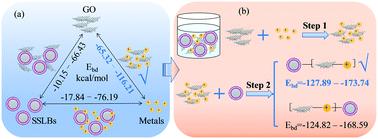当前位置:
X-MOL 学术
›
Environ. Sci.: Nano
›
论文详情
Our official English website, www.x-mol.net, welcomes your feedback! (Note: you will need to create a separate account there.)
Hydrogen bonding rather than cation bridging promotes graphene oxide attachment to lipid membranes in the presence of heavy metals
Environmental Science: Nano ( IF 7.3 ) Pub Date : 2020-06-12 , DOI: 10.1039/d0en00366b Huimin Li 1, 2, 3, 4, 5 , Haodong Ji 1, 2, 3, 4, 5 , Ruijie Zhang 1, 2, 3, 4, 5 , Wei Zhang 6, 7, 8, 9, 10 , Baozhu Pan 5, 11, 12, 13 , Wen Liu 1, 2, 3, 4, 5 , Weiling Sun 1, 2, 3, 4, 5
Environmental Science: Nano ( IF 7.3 ) Pub Date : 2020-06-12 , DOI: 10.1039/d0en00366b Huimin Li 1, 2, 3, 4, 5 , Haodong Ji 1, 2, 3, 4, 5 , Ruijie Zhang 1, 2, 3, 4, 5 , Wei Zhang 6, 7, 8, 9, 10 , Baozhu Pan 5, 11, 12, 13 , Wen Liu 1, 2, 3, 4, 5 , Weiling Sun 1, 2, 3, 4, 5
Affiliation

|
Interactions between graphene oxide (GO) and cell membranes play a crucial role in the nanotoxicity of GO toward organisms. However, little is known about interactions of GO with lipid membranes in the presence of heavy metals. This study investigated the attachment of GO and adsorption of heavy metals onto simulated cell membranes (spherical supported lipid bilayers, SSLBs) formed by cationic, neutral and anionic lipids, i.e., SSLB(+), SSLB(0) and SSLB(−), using batch experiments, density functional theory (DFT) calculations, and spectroscopic analyses. In the binary systems, the SSLBs bind with GO through hydrogen binding and with heavy metals via complexation. The attachment of GO or adsorption of heavy metals onto SSLBs decreased in the order SSLB(−) > SSLB(0) > SSLB(+), largely controlled by the type and number of functional groups in the SSLBs. Evidence from batch experiments, DFT calculations and spectroscopic analyses confirmed that in the ternary system GO first binds with metals, and then the GO–metal complexes attach to SSLBs via hydrogen bonding through GO rather than cation bridging through metals. Moreover, metal adsorption onto GO strengthens hydrogen bonding by withdrawing electrons from the GO surface. Therefore, in the ternary system, heavy metals promoted the GO attachment to SSLBs. However, GO suppressed the adsorption of heavy metals onto SSLBs by blocking the adsorption sites via steric hindrance. This study highlighted the importance of molecular interactions on assessing the nanotoxicity of GO to cells in the coexistence of heavy metals.
中文翻译:

在重金属存在下,氢键结合而不是阳离子桥联促进氧化石墨烯附着在脂质膜上
氧化石墨烯(GO)与细胞膜之间的相互作用在GO对生物体的纳米毒性中起着至关重要的作用。然而,关于重金属存在下GO与脂质膜的相互作用了解甚少。这项研究调查了GO的附着以及重金属对阳离子,中性和阴离子脂质,即SSLB(+),SSLB(0)和SSLB(-)形成的模拟细胞膜(球形支持脂质双层,SSLB)的吸附,使用批处理实验,密度泛函理论(DFT)计算和光谱分析。在二元系统中,SSLB通过氢键与GO结合,通过复杂化。GO的附着或重金属在SSLB上的吸附以SSLB(-)> SSLB(0)> SSLB(+)的顺序减少,这在很大程度上受SSLB中官能团的类型和数量的控制。批处理实验,DFT计算和光谱分析的证据证实,在三元系统中,GO首先与金属结合,然后GO-金属配合物通过GO上的氢键连接而不是通过金属上的阳离子桥键连接到SSLB 。此外,金属吸附在GO上会通过从GO表面抽出电子来加强氢键。因此,在三元体系中,重金属促进了GO与SSLB的连接。但是,GO通过阻断吸附位点来抑制重金属吸附到SSLB上。位阻。这项研究强调了分子相互作用在重金属共存时评估GO对细胞的纳米毒性的重要性。
更新日期:2020-08-14
中文翻译:

在重金属存在下,氢键结合而不是阳离子桥联促进氧化石墨烯附着在脂质膜上
氧化石墨烯(GO)与细胞膜之间的相互作用在GO对生物体的纳米毒性中起着至关重要的作用。然而,关于重金属存在下GO与脂质膜的相互作用了解甚少。这项研究调查了GO的附着以及重金属对阳离子,中性和阴离子脂质,即SSLB(+),SSLB(0)和SSLB(-)形成的模拟细胞膜(球形支持脂质双层,SSLB)的吸附,使用批处理实验,密度泛函理论(DFT)计算和光谱分析。在二元系统中,SSLB通过氢键与GO结合,通过复杂化。GO的附着或重金属在SSLB上的吸附以SSLB(-)> SSLB(0)> SSLB(+)的顺序减少,这在很大程度上受SSLB中官能团的类型和数量的控制。批处理实验,DFT计算和光谱分析的证据证实,在三元系统中,GO首先与金属结合,然后GO-金属配合物通过GO上的氢键连接而不是通过金属上的阳离子桥键连接到SSLB 。此外,金属吸附在GO上会通过从GO表面抽出电子来加强氢键。因此,在三元体系中,重金属促进了GO与SSLB的连接。但是,GO通过阻断吸附位点来抑制重金属吸附到SSLB上。位阻。这项研究强调了分子相互作用在重金属共存时评估GO对细胞的纳米毒性的重要性。


























 京公网安备 11010802027423号
京公网安备 11010802027423号